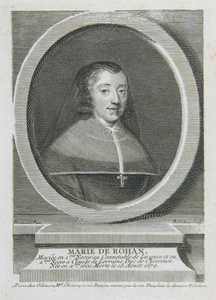| Method | Copper engraving |
| Artist | Jean Joseph Baléchou after Ferdinand Elle |
| Published | A Paris chez Odieuvre, Md. d'Estampes rüe Danjou entrant par la rüe Dauphine la derniere P. Cachere [c.1755] |
| Dimensions | Image 144 x 102 mm, Plate 156 x 110 mm, Sheet 230 x 160 mm |
| Notes |
Inscription reads: 'Mariée en 1res Noces au Connetable de Luynes et en 2des Noces à Claude de Lorraine Duc de Chevreuse, Nee en xbre. 1600, Morte le 13, Aoust 1679.' From Dreux du Radier's L'Europe illustre. Marie de Rohan (1600 - 1679) was the daughter of Hercule de Rohan and Madeleine de Lenoncourt. The French aristocrat married Charles d'Abert, Duke of Luynes, in 1617, and it was through him that her political intrigue grew, and she gained confidence with the king and queen. Her first husband died in 1621, and in the following year, she married Claude of Lorraine, Duke of Chevreuse. Although a close friend of the queen, Marie was banished from the court following the queen's miscarriage, which is said to have been a result of Marie encouraging the queen to join in with boisterous games. Marie swiftly fell out of favour, and was famed for being involved in a number of 17th century conspiracies. Jean Joseph Baléchou (1716 - 1764) was a French printmaker. He trained in Avignon, and in 1734, travelled to Paris where he studied under Lepicié. Baléchou was extremely successful, but a scandal arose regarding the number of impressions he printed of his portrait of the King of Poland, which caused him to return to Avignon. Ferdinand Elle (1570 1637) was a French portrait painter, with very few of his works surviving. His was teacher to his son, Louis Ferdinand Elle the Elder, and Nicolas Poussin, and from 1601, he acted as court painter to Louis XIII. Ex.Col.: House of Savoy Condition: Water stain to right edge of sheet, and residue from framing tape along top edge. |
| Framing | unmounted |
| Price | £30.00 |
| Stock ID | 40083 |

